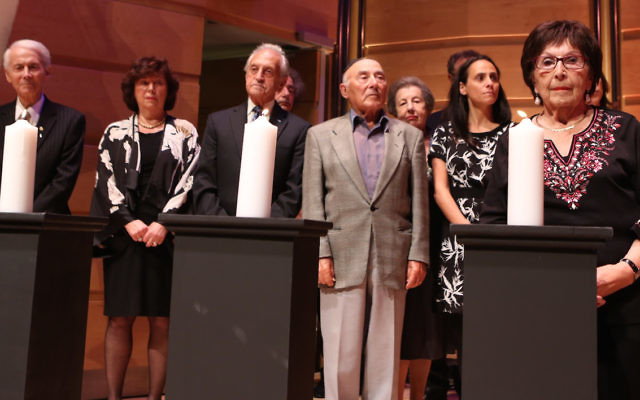Yom Hashoah: Memorials and memories
THIS year's theme for the Sydney Yom Hashoah commemoration is "Memorials and Memories". How do we keep history alive in our communities? asks Danny Hochberg.

THIS year’s theme for the Sydney Yom Hashoah commemoration is “Memorials and Memories”. How do we keep history alive in our communities? asks Danny Hochberg.
With the slow demise of our dear and cherished Holocaust survivors, how will we continue to remember the six million Jews murdered for who they were – and not for what was done to them? How to represent a tragedy that is characterised by absence, from the missing bodies to the destroyed gas chambers, the absence of names and archives?
Memorials and monuments reflect, in part, the ways that communities and individuals have answered these questions. All around the globe, including here in Australia, people have built memorials to commemorate the Holocaust. Each tries to preserve the collective memory of the generation that built the memorial and to shape the memories of generations to come.
The Holocaust poses new challenges for commemorative representations. Should memorials be introspective, specific to the needs of our community, or should they speak to a wider audience, with a universal message? Writing of memorials in Germany, Ian Buruma talks about Holocaust memorials as “monuments of warning”.
The recently opened permanent section of the Australian War Memorial museum devoted to the Holocaust reinforces this concept. The exhibition represents the Holocaust through the experiences of some of the survivors who made new lives in postwar Australia, as well as those of Australian official war artist Alan Moore, who accompanied British troops as they liberated the Bergen-Belsen.
It was a controversial addition, with some saying that the exhibition had little to do with the Australian war experience. But museum director, Dr Brendan Nelson, a major supporter of its inclusion, sees it differently.
In his own words: “It has everything to do with us, for we are a part of human kind. In a world grappling with the mass movement of people; the persecution of political, religious and ethnic minorities; euthanasia and a generational struggle against resurgent totalitarianism in the form of those who have hijacked the good name of Islam to build a violent political utopia, we must remind ourselves of that of which humankind is capable.”
The passing of the survivors places added weight to the message that our memorials are designed to impart. But can memorials alone live up to the expectations of memory? The German national Memorial to the Murdered Jews of Europe in the heart of Berlin illustrates this point. Designed by architect Peter Eisenman, the memorial, arranges 2711 rectangular-like tombstones in a grid. The architect aimed for minimalism and abstraction, and wanted visitors to wander through the memorial and experience an uncanny and threatening feeling, meant to evoke the Nazi camps. But because of its extreme simplicity and the absence of markers specific to the Holocaust, the memorial is easily mistaken for an outdoors artwork for public enjoyment.
There is a Holocaust memorial at the entrance of the Jewish section of the Melbourne General Cemetery in Carlton, depicting a menorah. And there are specific memorials to the Holocaust located in Springvale Cemetery. They range from a general commemoration of the Shoah to commemorations built by specific communities such as the Buchenwald concentration camp, the Krakow Jewish community, Mlawa Ghetto, and more. Many are beautiful, evoking a sadness and loss that is tangible. But their location in a cemetery does not allow easy access, with only the surrounding graves for company, many of them perhaps appropriately, the survivors of the Holocaust.
So what of our Holocaust memorials? I fear they are destined to anonymity. Built by survivors to provide a physical repository for their memories, with their passing, and given the difficult locations, it is unlikely that they will retain their relevance to future generations.
Interestingly, the opposite is the case in Anzac commemoration, where the strongly ceremonial nature of the commemoration, and the proliferation of memorials combined with a renewed interest in remembrance, has revitalised these sanctuaries.
Currently our main community commemorations take place in halls. Perhaps if there were public memorials, it could provide a focal point for future commemoration. Ideally they would be located in an accessible location, perhaps close to the main population centres of our Jewish communities. Glen Eira Council, in the heart of the Jewish community of Melbourne is considering the construction of a memorial to celebrate the lives of those who survived the Holocaust and their contribution to Australia, as well as the six million Jews who died.
With the passing of the survivors, perhaps the story requires telling, and a different type of memorial is required, one that is less ambiguous and more educational. This emphasises the importance of institutions such as the Melbourne Jewish Holocaust Centre, which seek to educate as well as commemorate.
Avril Alba, the project director/consulting curator responsible for the redesign of the Sydney Jewish Museum, in her essay – “Transmitting the Survivor’s Voice: Redeveloping the Sydney Jewish Museum” – explains that “while the museum’s original exhibition from the 1980s emphasised the Jewish survivors’ personal experiences, the recently redesigned exhibition strives to impart a more universalistic set of lessons while preserving the museum’s original vision of representing survivor voices”.
Thus the museums serve a dual role of both commemoration and education. Whether a physical memorial exists or not, there remains the ongoing need for education, among the Jewish and wider community. And importantly, the need to commemorate annually, to provide an annual marker for Jews and non-Jews to remember, reflect, and learn from the lessons of the Holocaust. Only through this, can the murder of so many innocent people achieve some meaning.
Danny Hochberg is chair of the NSW Jewish Board of Deputies’ Shoah Commemoration Committee.

comments